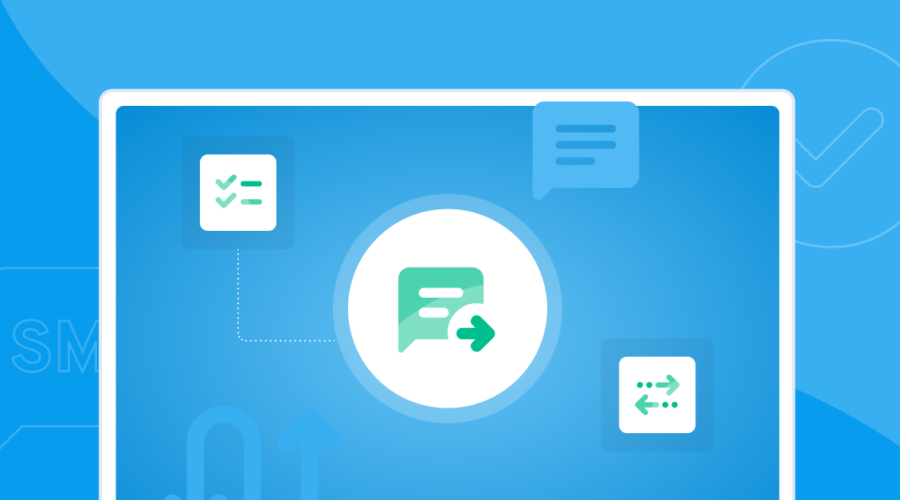There is no shortage of ways to connect with consumers today, but when you take the plunge into business messaging, the options can be overwhelming.
Short codes, toll-free, 10DLC, Global 2-way, Alphanumeric, RCS, OTT – where do you even begin?
A simple way to approach all of these options is by placing them into two buckets – notifications and conversations. Using these categories as a lens can help bring you closer to the use case at the center of your messaging strategy, and make your channel decisions simpler and clearer.
When to Use Notifications
A messaging notification may or may not ask the recipient to do something – like click a URL – but it will not require back and forth texting.
Typically, business SMS notifications are sent using one of three types of numbers or IDs: short codes, toll-free (US/CAN), or alphanumeric sender IDs (180+ counties outside the US).
Short codes are business messages sent from a 5-6 digit code instead of a full phone number. Short codes were the first A2P messaging options, so many consumers recognize them as coming from a business.
Toll-free numbers are the kind that begin with 800, 888, 866, etc. These kinds of numbers have been used by businesses for decades, so customers easily recognize them. This makes them ideal for high-throughput enterprise communication since most users assume a business representative is on the other end.
Alphanumeric sender IDs messages use a string of letters in place of a traditional number type one-way texting between a business and an opted-in user. This method is more popular in most of Europe, the Asia Pacific region, and Latin America.
SMS Notifications in the Real World
You’ve likely seen notification messages when you’re sent a one-time password to verify your identity, or when your doctor’s office sends you an appointment reminder.
They’re also useful in the banking industry to alert customers of suspicious activity on their accounts. instant communication allows customers to address issues right away and helps them build trust with their financial institutions.
Notifications are ideal for high-throughput communication with little or no response from the recipients. They are intended for one-way communication, but they can also use certain keywords to initiate more information, like when viewers vote via text in tv talent competition shows.
Consider times when you’ve received a business text notification asking to confirm an appointment with a “YES.” The YES or NO response may elicit more information on the upcoming appointment.
Banks and fintech companies use notifications to alert customers when deposits are received or when account balances dip. Credit card companies help prevent fraud by sending texts that let consumers monitor every transaction on their cards.
And of course, notification texts let you alert large groups with urgent updates. Like school delays and cancellations, crisis situations, and more.
Set a smarter text strategy this year
Access our latest research in the State of Messaging report, complete with exclusive survey results, case studies, and trend analysis.
When to Use Conversations
Unlike notifications, conversational texts allow customers to reply with comments and questions that require a response from the customer. They begin a dialogue – a conversation – with critical real-time engagement. On the side of the business, a person or a bot can be driving this conversation.
These messaging conversations are sent via one of four types of numbers: 10DLC, Global 2-way SMS, RCS, and Over-the-Top.
The 10-digit long code (10DLC) numbers are local numbers used by businesses. You may see these used by the small business owners or contractors in your network.
Global 2-way SMS starts SMS conversations with a distinct number specific to the country the message is being delivered in, and Rich Communication Services (RCS) allows users to send messages that include multimedia.
Over-the-Top messaging uses apps and services over the internet instead of traditional wireless, wired, or cable operators. These include platforms like WhatsApp, Facebook Messenger, or Apple Business Chat.
Toll-free numbers are helpful for two-way messaging because they have instant recognition as business numbers. And with that recognition comes trust. Plus, they can be voice-enabled so customers can both text and talk with customer service on the same numbers.
SMS Conversations in the Real World
Most people see these types of communications when they’re asked to take customer satisfaction surveys or even political polls.
They’re incredibly useful in handling day-to-day customer questions and needs. For example, the healthcare industry can use SMS message conversations to answer questions about appointment scheduling, payment management, and even distributing follow-up information. This is increasingly important for many patients who can easily engage in a text thread, but may not be willing or available to step away for a phone conversation on the same topic during business hours.
Travel and tourism companies can keep in touch with customers on the go by initiating messaging conversations around reservations, delays, and cancellations. As a result, travelers can make changes and feel secure that their travel company has them covered.
Salespeople can use 2-way texting to schedule time with prospects, and answer questions that come up along the way. Teachers can have 1:1 conversations with parents or students to answer questions about assignments. Civic groups can easily coordinate with volunteers… The possibilities are endless.
How Can Bandwidth Help?
Whether you need Short Codes, 10DLC, toll-free or global business messaging, Bandwidth has an option to help you connect directly with your customers. Our messaging APIs can help you embrace the power of text messaging to start valuable conversations.




